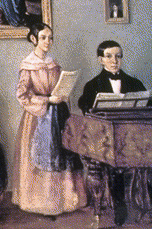|
Composers

Schubert

Schumann

Brahms

Mendelssohn

Mahler
|
Lied
The German lied (song), which existed in earlier periods,
peaked during the romantic period, especially in the work of
lied (song), which existed in earlier periods,
peaked during the romantic period, especially in the work of  Schubert Schubert ,
who wrote over 600 lieder (plural for lied), and placed, for the first
time in history, the secular song at the same level as the most important
forms of musical expression. In the romantic
period ,
who wrote over 600 lieder (plural for lied), and placed, for the first
time in history, the secular song at the same level as the most important
forms of musical expression. In the romantic
period ,
lieder became a widely accepted form, when the piano ,
lieder became a widely accepted form, when the piano would usually accompany the singer, and in
fact was its equal in artistic part. "The
Trout"
would usually accompany the singer, and in
fact was its equal in artistic part. "The
Trout"   ("Die Forelle"),
one of Schubert's best loved lieder, became one of the popular classic
songs, as was the string quintet in which he combined its tune, called
"Die Forelle Quintet".
In addition to Schubert's known
lied cycles (collections), among which are "The
Winter Journey"
("Die Forelle"),
one of Schubert's best loved lieder, became one of the popular classic
songs, as was the string quintet in which he combined its tune, called
"Die Forelle Quintet".
In addition to Schubert's known
lied cycles (collections), among which are "The
Winter Journey" ("Winterreise")
and "The
Beautiful Miller" ("Die
schöne Mülllerin"), Mendelssohn
("Winterreise")
and "The
Beautiful Miller" ("Die
schöne Mülllerin"), Mendelssohn ,
Schumann ,
Schumann  ,
Brahms ,
Brahms and many other wrote lieder too, and Mahler
and many other wrote lieder too, and Mahler contributed us his "Elegies
on Children's Death" ("Kindertotenlieder")
and "Songs of a
Wandering Apprentice" ("Lieder
eines fahrende Gesellen") cycles. Another important
artist was Hugo Wolf
contributed us his "Elegies
on Children's Death" ("Kindertotenlieder")
and "Songs of a
Wandering Apprentice" ("Lieder
eines fahrende Gesellen") cycles. Another important
artist was Hugo Wolf ,
who developed this genre after Shcubert's demise. ,
who developed this genre after Shcubert's demise.

|
Xtend
 Listen
Listen
 Period
Period
 Dictionary
Dictionary
 Internet
Internet
 Projects
Projects
 Finders
Finders
|